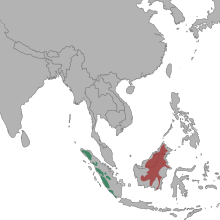Sunda clouded leopard
| Sunda clouded leopard Temporal range: Early to recent |
|
|---|---|
 |
|
| Sunda clouded leopard in lower Kinabatangan River, eastern Sabah, Malaysia | |
| Scientific classification | |
| Kingdom: | Animalia |
| Phylum: | Chordata |
| Class: | Mammalia |
| Order: | Carnivora |
| Family: | Felidae |
| Genus: | Neofelis |
| Species: | N. diardi |
| Binomial name | |
|
Neofelis diardi (G. Cuvier, 1823) |
|
| Subspecies | |
| (Wilting et al., 2007) (Wilting et al., 2007) | |
 |
|
| Range of Sunda clouded leopard | |
| Synonyms | |
|
Felis diardii |
|
Felis diardii
The Sunda clouded leopard (Neofelis diardi), also known as the Sundaland clouded leopard, is a medium-sized wild cat found in two Indonesian islands of Borneo and Sumatra. In 2006, it was classified as a separate species, distinct from its continental relative Neofelis nebulosa.
In 2008, the IUCN classified the species as Vulnerable, with a total effective population size suspected to be fewer than 10,000 mature individuals, and a decreasing population trend.
Previously, the species was known as the Bornean clouded leopard — a name publicised by the WWF in March 2007, quoting Dr. Stephen O'Brien of the U.S. National Cancer Institute as saying, "Genetic research results clearly indicate that the clouded leopard of Borneo should be considered a separate species".
The Sunda clouded leopard is the largest cat in Borneo, and has a stocky build, weighing around 12 to 26 kg (26 to 57 lb). The canine teeth are 2 inches (5.1 cm) long, which, in proportion to the skull length, are longer than those of any other extant cat. Its tail can grow to be as long as its body, aiding balance.
Its coat is marked with irregularly-shaped, dark-edged ovals which are said to be shaped like clouds, hence its common name. Though scientists have known of its existence since the early 19th century, it was positively identified as being a distinct species in its own right in 2006, having long been believed to be a subspecies of the mainland clouded leopard (Neofelis nebulosa).
Sunda clouded leopards are probably restricted to the islands of Borneo and Sumatra in Indonesia. In Borneo, they occur in lowland rainforest, and at lower density, in logged forest. Records in Borneo are below 1,500 m (4,900 ft). In Sumatra, they appear to be more abundant in hilly, montane areas. It is unknown if there are still Sunda clouded leopards on the small Batu Islands close to Sumatra.
...
Wikipedia

